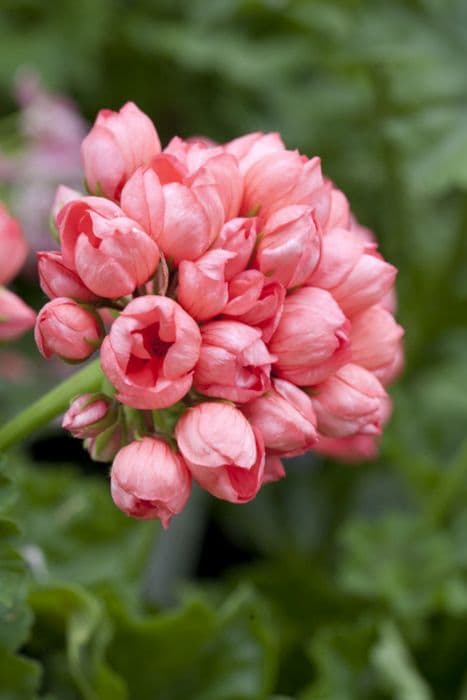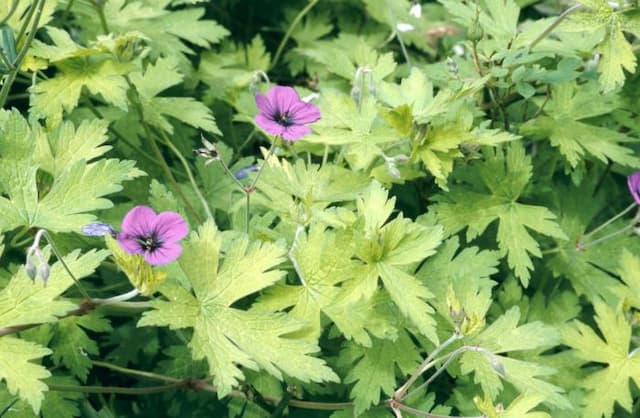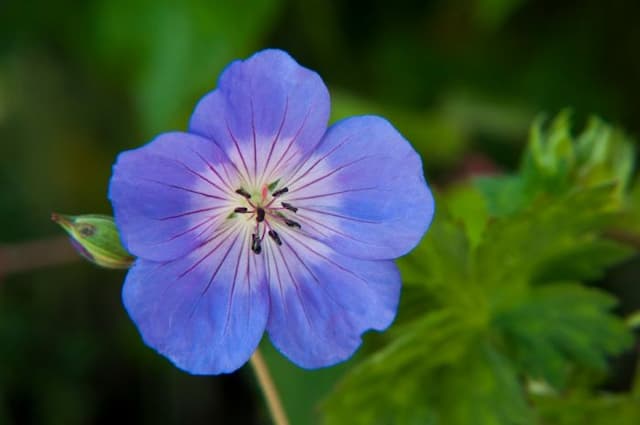Geranium Pelargonium 'Patricia Andrea' (Z/t)

ABOUT
Pelargonium 'Patricia Andrea' is a type of geranium that is admired for its ornamental qualities. This plant is distinguished by its lush foliage, which typically presents as bright green leaves that are pleasantly fragrant when touched or brushed against. The leaves have a heart-like shape and may display slightly scalloped or lobed edges, which contribute to the plant's overall visual interest. The flowers of 'Patricia Andrea' are particularly eye-catching, often showcased in clusters that bloom profusely throughout the growing season. These blossoms exude a certain elegance and come in an array of vibrant colors, ranging from shades of pink to red, or sometimes with unique bi-colored patterns. Each individual flower is made up of rounded petals that are slightly overlapped, with a typical geranium appearance that may include darker streaks or veins adding contrast and depth to the petal colors. Adding to its charm, this geranium variety often possesses long, slender stems that hold the flower heads aloft above the main body of foliage, creating a delightful display that attracts both visual admiration and visiting pollinators. Overall, Pelargonium 'Patricia Andrea' exudes a lush and robust presence in any garden or container where it is planted, with its attractive blooms and foliage providing much aesthetic pleasure.
About this plant
 Names
NamesFamily
Geraniaceae
Synonyms
Patricia Andrea Geranium, Zonal Geranium
Common names
Pelargonium 'Patricia Andrea'
 Toxicity
ToxicityTo humans
Pelargoniums, commonly known as geraniums, are typically not considered highly toxic to humans. However, ingestion of parts of geranium may potentially cause minor symptoms such as nausea, vomiting, or diarrhea in some individuals, particularly if consumed in large amounts. There is also the possibility of skin irritation if there is contact with the sap, particularly for those with sensitive skin or allergies.
To pets
Geraniums are known to be toxic to pets, especially to dogs and cats. If a pet ingests part of a geranium, they could exhibit symptoms such as vomiting, depression, anorexia, and dermatitis. While generally not considered life-threatening, ingestion of geraniums can cause discomfort and illness, so it is advisable to keep these plants out of reach of pets to avoid any potential issues.
 Characteristics
CharacteristicsLife cycle
Perennials
Foliage type
Semi-deciduous
Color of leaves
Green
Flower color
Varies
Height
1-2 feet (30-60 cm)
Spread
1-2 feet (30-60 cm)
Plant type
Herb
Hardiness zones
10
Native area
South Africa
Benefits
 General Benefits
General Benefits- Aesthetic Appeal: Adds vibrant color and texture to gardens with its unique and attractive flowers.
- Low Maintenance: Typically easy to care for, requiring minimal attention once established in the right conditions.
- Drought Resistance: Can survive with limited water, making it suitable for areas with water restrictions or xeriscaping.
- Attracts Pollinators: Flowers can attract beneficial insects like bees and butterflies, aiding in the pollination of surrounding plants.
- Long Blooming Season: Often has a prolonged flowering period, providing color and interest for an extended time.
- Versatility: Suitable for planting in a variety of settings including borders, containers, and hanging baskets.
- Scented: Some varieties have fragrant leaves or flowers, which can add pleasant scents to the garden or indoors.
- Culinary Uses: Certain types of the plant are used in cooking for flavoring, although this should be confirmed with a particular variety like Pelargonium 'Patricia Andrea'.
 Medical Properties
Medical PropertiesThis plant is not used for medical purposes.
 Air-purifying Qualities
Air-purifying QualitiesThis plant is not specifically known for air purifying qualities.
 Other Uses
Other Uses- Pelargonium 'Patricia Andrea' can be used as a natural dye source for fabrics, imparting subtle colors derived from its leaves and flowers.
- The aromatic leaves of the geranium may be infused in water to create a flavored water beverage, though consumption should always respect individual plant safety and allergy considerations.
- With its attractive color and shape, geraniums like 'Patricia Andrea' can serve as living decorations for cakes and culinary presentations, as long as they are not treated with any harmful chemicals.
- Leaves from the geranium can be placed among linens or clothing to impart a fresh, floral scent, acting as a natural alternative to commercial drawer sachets.
- Pressed leaves or flowers from Pelargonium 'Patricia Andrea' can be used to create botanical art, suitable for greeting cards or décor.
- The geranium can be utilized in potpourri mixes, contributing both color and fragrance to the blend.
- Dried leaves from the plant can be incorporated into homemade soaps or bath bombs, adding both visual appeal and fragrance.
- Pelargonium 'Patricia Andrea' can be used in creative landscape designs, given its vivid color and unique foliage, which can enhance garden aesthetics beyond traditional ornamental roles.
- The strong scent of geranium leaves can act as a deterrent for small animals and certain insects in the garden, serving as a natural form of pest control.
- The plant can be part of educational activities for children or gardening enthusiasts, demonstrating plant care, growth cycles, and propagation techniques.
Interesting Facts
 Feng Shui
Feng ShuiThe Geranium is not used in Feng Shui practice.
 Zodiac Sign Compitability
Zodiac Sign CompitabilityThe Geranium is not used in astrology practice.
 Plant Symbolism
Plant Symbolism- Comfort and Healing: Often associated with therapeutic properties, geraniums, like the 'Patricia Andrea' variety, are frequently used in aromatherapy and believed to promote emotional healing.
- Femininity and Grace: The delicacy of the geranium's petals is emblematic of feminine beauty and poise, fitting for a plant named 'Patricia Andrea'.
- Friendship: Geraniums are given as gifts to signify both new and enduring friendships.
- Protection: In some folklore, geraniums are thought to ward off negative energies and are sometimes planted in gardens for this protective symbolism.
 Water
WaterGeranium 'Patricia Andrea' should be watered thoroughly when the top inch of soil feels dry to the touch, which often equates to watering once a week. Depending on temperature and humidity conditions, this frequency may vary. It's recommended to provide about one gallon of water per plant for each watering session, allowing excess water to drain away. Adjust watering during hot spells or in very dry conditions to maintain consistent soil moisture. Overwatering can lead to root rot, so make sure not to let the plant sit in water.
 Light
LightGeraniums like 'Patricia Andrea' thrive in bright, indirect light. Place it in a spot where it can receive at least six hours of daylight, avoiding direct scorching sunlight which can burn the leaves. A window with eastern or western exposure typically works well for these plants, ensuring they get enough light without the harsh midday sun.
 Temperature
TemperatureGeranium 'Patricia Andrea' prefers temperatures between 65 and 75 degrees Fahrenheit during the day and should not be subjected to temperatures below 55 degrees Fahrenheit, as it is not frost-tolerant. Keeping it within this range will promote healthy growth. However, the plant can tolerate occasional deviations as long as they are not extreme or prolonged.
 Pruning
PruningPrune Geranium 'Patricia Andrea' to encourage bushier growth, remove dead or yellowing leaves, and to maintain a desired shape. Light pruning can be done throughout the year, but the best time for major pruning is early spring. Remove spent flowers to promote continuous blooming.
 Cleaning
CleaningAs needed
 Soil
SoilFor the Geranium 'Patricia Andrea', use a well-draining potting mix with peat, perlite, and compost. Aim for a soil pH between 6.0 and 7.0 for optimal growth.
 Repotting
RepottingGeraniums like 'Patricia Andrea' should be repotted every 1 to 2 years to refresh the soil and accommodate root growth.
 Humidity & Misting
Humidity & MistingGeranium 'Patricia Andrea' prefers moderate humidity but is adaptable and can tolerate indoor environments well.
 Suitable locations
Suitable locationsIndoor
Place in bright, indirect light and water when topsoil is dry.
Outdoor
Full sun to partial shade, protect from frost, well-draining soil.
Hardiness zone
10-11 USDA.
 Life cycle
Life cyclePelargonium 'Patricia Andrea', commonly referred to as Geranium 'Patricia Andrea', begins its life as a seed, entering a germination stage where warmth and moisture trigger the development of the first roots and shoots. These seedlings then grow into juvenile plants with characteristic geranium foliage and stem structure. As the plant matures, it enters the vegetative stage where it focuses on leaf and stem growth, and when conditions are favorable, it transitions to the flowering stage, producing vibrant blooms that are often used for ornamental purposes. After pollination, if it occurs, the flowers develop into fruit structures called schizocarps, which eventually dry and release the seeds, completing the reproductive cycle. In cultivation, Geranium 'Patricia Andrea' can be propagated both by seeds and vegetative cuttings, the latter skipping the seed stage and directly producing a new, genetically identical plant. Throughout the growing season, this perennial plant can go through multiple cycles of vegetative growth and flowering, especially with proper care and pruning to encourage recurrent blooming.
 Propogation
PropogationPropogation time
Spring-Early Summer
Propogation: The Pelargonium 'Patricia Andrea', commonly known as a type of geranium, is typically propagated through stem cuttings. This process is best performed in late spring to early summer when the plant is actively growing. Cuttings should be about 4-6 inches (10-15 cm) long and taken from healthy, non-flowering stems. Remove the leaves from the bottom half of the cutting and dip the cut end in rooting hormone to facilitate root development. Plant the cutting in a well-draining soil mix, ensuring that the leafless part of the stem is buried. Keep the soil lightly moist and place the pot in a warm, well-lit area but out of direct sunlight. Roots usually develop within a few weeks, after which the new plants can be gradually acclimated to more sun and eventually transplanted outside if desired.









